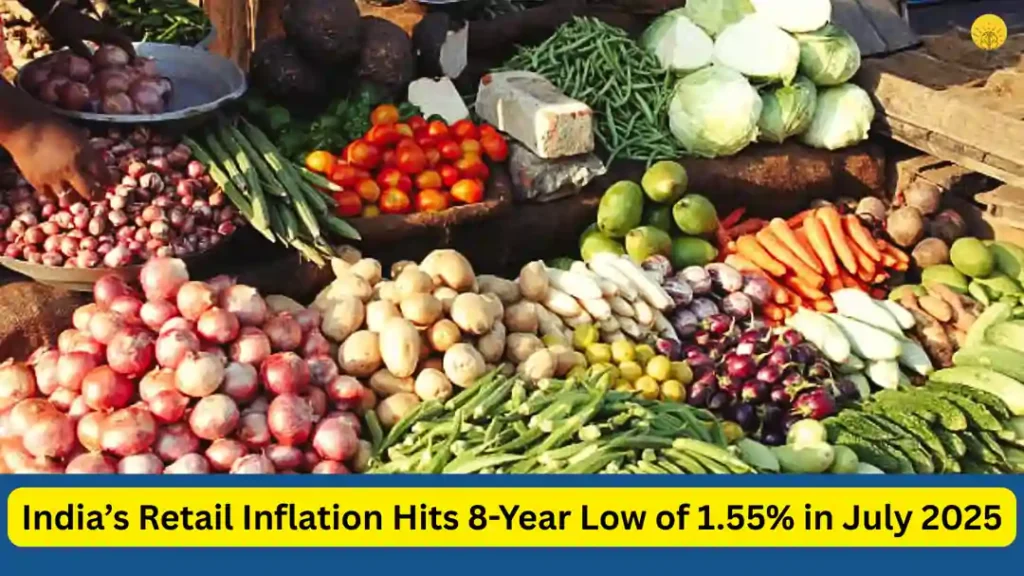New Delhi: India’s retail inflation plummeted to an eight-year low of 1.55% in July 2025, marking a significant economic moment. According to the All India Consumer Price Index (CPI), this is the lowest year-on-year inflation rate since June 2017, when it stood at 1.46%. This decline, driven by falling food prices and a favorable base effect, has sparked discussions about its implications for households, policymakers, and the broader economy.

A Milestone in Inflation: The Numbers Explained
In July 2025, India’s retail inflation, as measured by the CPI, dropped to 1.55%, down from 2.10% in June 2025, according to data released by the Ministry of Statistics and Programme Implementation on August 12, 2025. This marks the ninth consecutive month of easing inflation, a trend that has caught the attention of economists and policymakers alike. The Consumer Food Price Index (CFPI), which tracks food inflation, slipped into deeper deflation at -1.76% in July, the lowest since January 2019.
Breaking down the data, rural areas saw inflation soften to 1.18%, while urban areas recorded 2.05%. Food inflation mirrored this trend, with rural areas at -1.74% and urban areas at -1.9%. The CPI, a critical macroeconomic indicator, measures price changes in goods and services consumed by households. It serves as a tool for inflation targeting by the Reserve Bank of India (RBI), a deflator in national accounts, and a basis for indexing employee allowances. Published monthly on the 12th by the Central Statistical Office (CSO), the CPI includes four categories: Industrial Workers (IW), Agricultural Labourers (AL), Rural Labourers (RL), and Urban Non-Manual Employees (UNME), with 2012 as the base year.
Why Is Inflation So Low?
The sharp decline in inflation stems from multiple factors, with a favorable base effect being a primary driver. This effect occurs when high inflation in the corresponding period of the previous year (July 2024) makes current figures appear lower. Specifically, steep price drops in key food items fueled the trend. Vegetable prices contracted by 20.69% (or 21% per some sources), pulses by 13.76% (or 14%), and spices by 3.1%. Other items like meat, cereals, eggs, and sugar also saw reduced inflation.
The food and beverages category recorded an inflation rate of -0.8% in July 2025, down from -0.2% in June and a stark contrast to 5.1% in July 2024. Month-on-month, vegetable prices saw a slight seasonal uptick, but pulses continued to decline. Other CPI categories showed varied trends: pan, tobacco, and intoxicants remained steady at 2.4%, clothing and footwear eased slightly to 2.5%, housing held at 3.2%, and fuel and light rose to 2.7% from 2.5%.
Core inflation, which excludes volatile food and fuel prices, eased to 4.1% from 4.4%, aligning closely with the RBI’s 4% target. This moderation was driven by lower transport and communication costs (due to a base effect from last year’s telecom tariff hike) and slight softening in education costs, though healthcare and personal care saw marginal increases.
Expert Perspectives on the Trend
Economists have offered nuanced views on this inflation slowdown. Rajani Sinha, Chief Economist at CareEdge Ratings, attributed the deflation in food items like vegetables, pulses, spices, and meat to the low headline numbers. She highlighted that robust agricultural activity, supported by a strong monsoon, adequate reservoir levels, and solid kharif sowing, should keep food inflation subdued moving forward.
Dipanwita Mazumdar from Bank of Baroda emphasized the role of the high base effect, predicting low inflation through December 2025. She noted that global commodity prices are likely to remain stable, countering some impacts of new U.S. tariffs, though India must monitor potential disruptions if forced to halt Russian oil imports, suggesting Kuwait and Iraq as alternative sources.
Madan Sabnavis, also from Bank of Baroda, described the figures as anticipated, with limited impact on RBI policy. He cautioned that falling food prices could hurt farmers’ incomes, but higher rural wages and expected strong crop yields should mitigate this.
Upasna Bhardwaj of Kotak Mahindra Bank pointed out that while food inflation drove the low print, core inflation remains sticky, reflecting persistent pressures in non-food sectors. Sankar Chakraborti of Acuit Ratings & Research forecasted CPI below 3.0% until December 2025, revising the FY26 target to 3.0% from 3.5%, assuming normal monsoons.
Sujan Hajra from Anand Rathi Group suggested that the RBI’s lowered 3.1% annual forecast might be undershot, raising prospects for rate cuts, especially given U.S. tariffs potentially reducing GDP growth by 30-40 basis points. Tanvee Gupta Jain of UBS Securities noted that refined core inflation (excluding energy and gold) fell to 3.1%, with sticky pressures in health (4.6%) and education (4.0%).
Radhika Rao of DBS Bank described the 1.6% year-on-year figure as slightly above expectations but driven by food and base effects, with vegetables showing sequential increases but pulses and cereals slowing.
Policy Implications and the RBI’s Stance
The 1.55% inflation rate falls below the RBI’s 2-6% tolerance band, a rare occurrence since January 2019. The RBI is required to justify breaches of this band for three consecutive quarters. While low inflation signals weak demand, potentially impacting rural spending and farm incomes, policymakers view this as temporary due to volatile food prices.
The RBI recently cut its FY26 inflation forecast to 3.1% from 3.7% and maintained steady interest rates, citing strong domestic growth. However, new U.S. tariffs of 25% (raising duties to 50% on 55% of India’s U.S. exports) could complicate this outlook. Some economists, like Hajra, see room for rate cuts to offset tariff-related growth impacts.
India Ratings and Research predicts a slight uptick to 2.1% in August due to rising prices of items like tomatoes. Geopolitical risks, such as potential oil supply shifts, remain a concern, with Mazumdar suggesting diversification to Middle Eastern suppliers.
Are Households Feeling the Relief?
Despite the headline number, many Indian households report little relief. The sharp inflation drop is largely a statistical outcome of the base effect, with 2024’s high food inflation skewing comparisons. Core inflation at 4.1% better reflects household experiences, with health (4.6%), education (4.0%), and housing costs remaining elevated.
The CPI basket, rooted in 2011-12 consumption patterns, overemphasizes food, which urban households now spend less on compared to healthcare, education, housing, and tech services—categories with higher inflation. Nominal wage growth of 9.5% translates to 4-7% real growth after inflation and taxes, but rising EMIs and household debt (doubled over the past decade) consume much of this. Household savings have hit a record low of 18% of GDP, worsened by lifestyle inflation from pricier education, healthcare, and technology.
This creates a paradox: while official figures suggest stability, everyday costs keep rising, leaving millions feeling squeezed. For farmers, falling food prices threaten incomes, though strong agricultural output may cushion this.
CPI vs. WPI: A Comparative Lens
The CPI differs from the Wholesale Price Index (WPI), which tracks wholesale-level inflation. Food carries more weight in the CPI, while fuel dominates the WPI, leading to divergent trends. This distinction highlights why retail inflation may not fully align with wholesale price movements.
Conclusion: A Balancing Act Ahead
India’s retail inflation at 1.55% in July 2025 positions it as a stable market globally, especially as many economies grapple with 3-4% inflation. However, the disconnect between headline numbers and household realities underscores the need for broader price moderation. With U.S. tariffs, geopolitical risks, and sticky core inflation in focus, the RBI faces a delicate balancing act. As agricultural output strengthens and base effects fade, the coming months will test whether this low inflation is sustainable or a fleeting statistical quirk.
FAQs
1. What caused India’s retail inflation to drop to 1.55% in July 2025?
The decline to 1.55% was primarily driven by a favorable base effect, where high inflation in July 2024 made current figures appear lower. Significant price drops in food items like vegetables (-20.69%), pulses (-13.76%), spices (-3.1%), and other categories such as cereals, eggs, and sugar also contributed. The Consumer Food Price Index (CFPI) fell to -1.76%, reflecting deflation in food prices, supported by strong agricultural output and a good monsoon.
2. Why don’t Indian households feel relief despite the low inflation rate?
While headline inflation is low, core inflation (excluding food and fuel) remains sticky at 4.1%, driven by high costs in health (4.6%), education (4.0%), and housing. The CPI basket, based on 2011-12 consumption patterns, overweights food and underrepresents modern expenses like healthcare and technology, which inflate faster. Rising EMIs, doubled household debt, and low real wage growth (4-7% after taxes and inflation) further strain budgets.
3. How does this inflation rate affect the Reserve Bank of India’s (RBI) policies?
At 1.55%, inflation is below the RBI’s 2-6% target band, a rare occurrence since January 2019. While this signals weak demand, the RBI views it as temporary due to volatile food prices and has held interest rates steady, citing strong growth prospects. However, new U.S. tariffs (25% additional duties) could shave 30-40 basis points off GDP growth, potentially prompting rate cuts if inflation remains low.
4. How does the Consumer Price Index (CPI) differ from the Wholesale Price Index (WPI)?
The CPI measures retail-level price changes for goods and services households consume, with a heavier weight on food. The WPI tracks wholesale-level inflation, emphasizing fuel. These differing weights cause variations in their trends, with CPI better reflecting household costs and WPI indicating broader market dynamics.
5. What is the outlook for inflation in the coming months?
Economists predict low inflation through December 2025 due to the high base effect, with forecasts below 3.0% and a FY26 target of 3.0%. A slight uptick to 2.1% is expected in August due to rising vegetable prices like tomatoes. Strong agricultural activity, supported by good monsoons and kharif sowing, should keep food inflation in check, though core inflation pressures in health and education persist.

